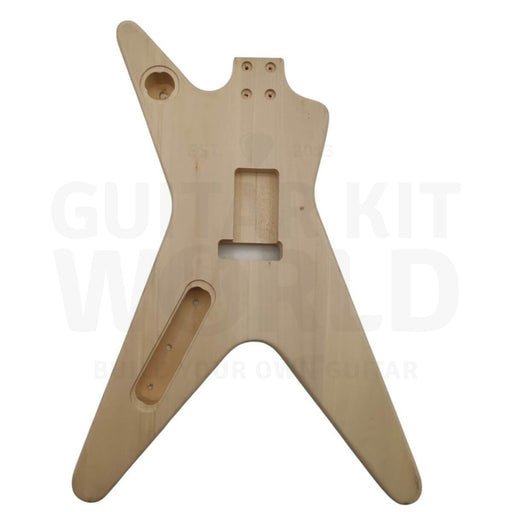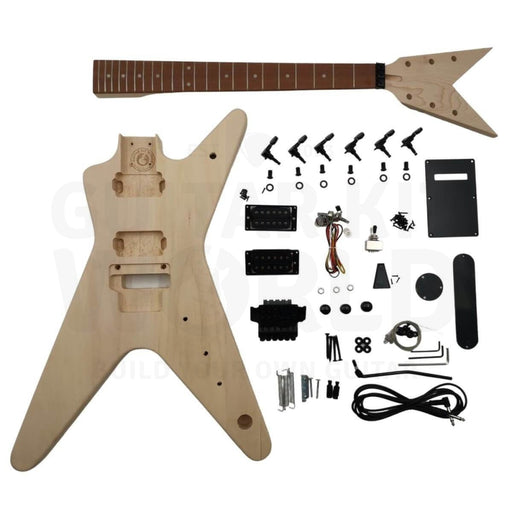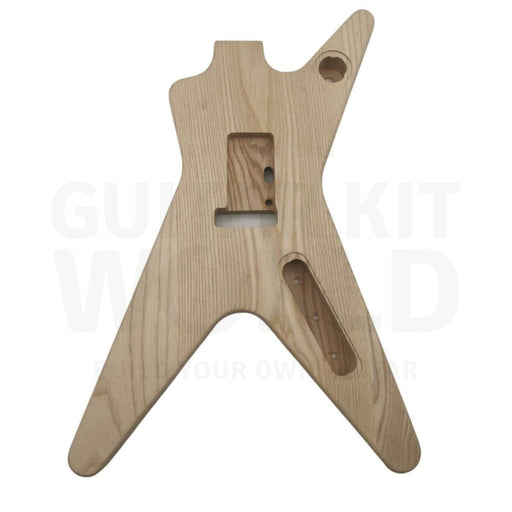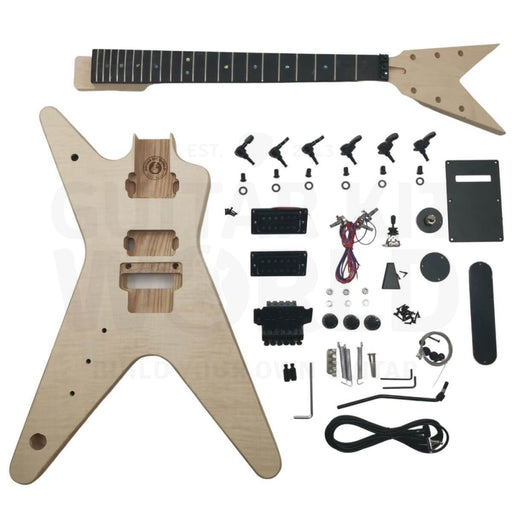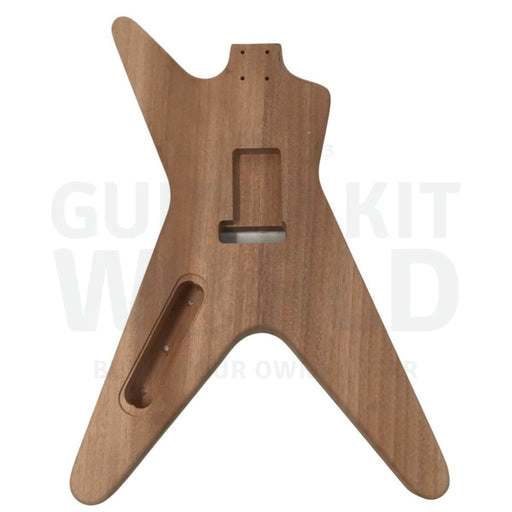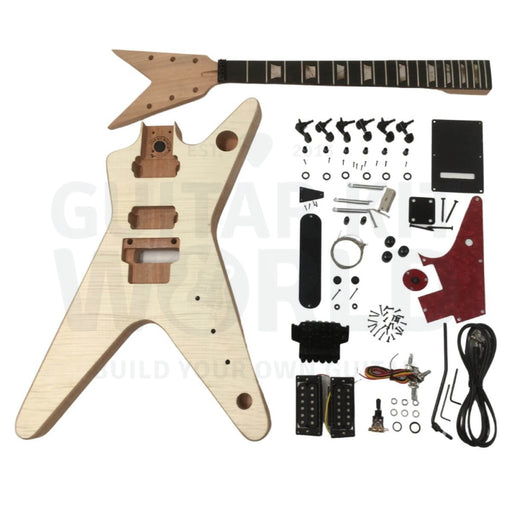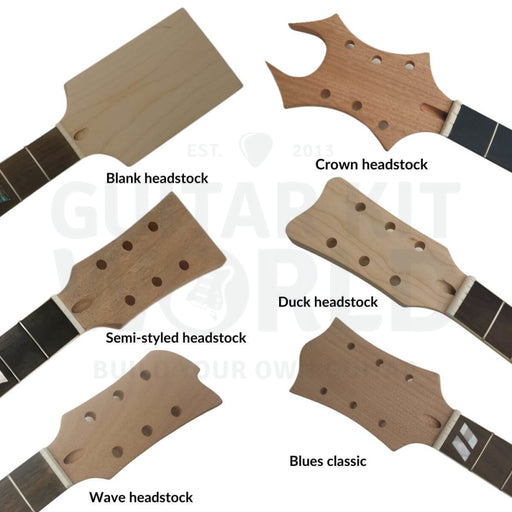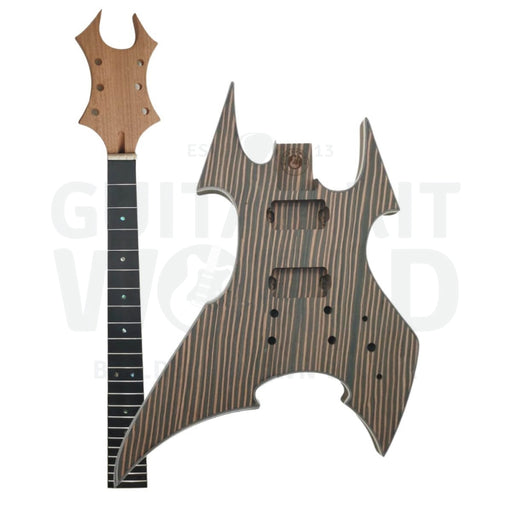X-shaped Guitar Kit Assembly Manual
This guide provides step-by-step instructions to build an X-Shaped DIY guitar using a kit. Even if you have never built before, you can learn how to get started by reading this tutorial.
There’s nothing more satisfying than playing a guitar you have put together yourself!
Project Tools and Consumables
Before we get started check the list below and ensure you have the necessary tools and consumables required to complete the project.
Tools
- 2 X Timber clamps (*for set neck guitars)
- Electric jigsaw or coping saw (*If shaping the headstock)
- Steel ruler (at least 40cm)
- Hard sanding block
- Center punch (or similar tool for marking hole locations)
- Electric drill and assorted drill bits
- Large and small screwdrivers (phillips head and flat head)
- Pliers (needle nose preferably)
- Soldering iron
Consumables
- Disposable gloves
- Titebond, PVA, or similar wood glue (*set neck guitar)
- Small paintbrush
- Wood grain filler (If open grain timber such as Mahogany or Oak)
- Sandpaper. Various grades, from 120 up to 1500 (*depends on finish)
- Finishing supplies. (This depends on your choice of finish)
- Painters masking tape
- Assortment of clean rags and paper towel
- Denatured alcohol (or cleaning product with degreasing ability)
- 0000 fine grade steel wool
- Solder (and sponge for cleaning tip of iron)
- Container for storing finishing supplies.
Next, check that all parts have been included.
Parts List
Below are the parts you will find included in your packaging to complete an X-Shaped DIY guitar.
- Prepped X-shape body
- Completed neck
- Neck plate, neck plate cushion and screws (if bolt-on neck)
- 2 x Strap buttons
- 6 inline tuners
- Stud mounted Tune-O-matic style bridge with tailpiece
- Neck and bridge humbuckers
- 2 x volume and 2 x tone controls. 2 x capacitors, 1 x 3 way pickup selector, and input jack
- Truss rod cover, pick guard and electronics cavity cover
- Cable and hex wrench (for adjusting truss rod)
- Tone and volume knobs
- Assorted screws and washers
Safety Precautions
To complete your guitar kit safely, also ensure you have the following on hand, and a well ventilated work space to work in.
Protective eyewear

Use protective safety glasses or a genuine face shield, not regular prescription, reading, or sunglasses.
Disposable gloves
Use disposable gloves if applying stains or oil finishes directly to the guitar.
Masks

Use an N95 rated dust mask for sanding and an R95 rated particle mask for finishing. If using water based finishing products an N95 dust mask may suffice for both sanding and finishing, but be sure to check the finishing suppliers recommendations first. Paint fumes are dangerous.
A well ventilated work area
Ensure your work space is well ventilated, especially when finishing to prevent a build up of potentially toxic fumes.
Making your Guitar Kit play and sound great
There are four stages to building a great kit guitar, these are:
1. Preparation and finishing
The finished surface appearance of your guitar e.g. staining, painting, or applying a hand rubbed oil finish.
2. Hardware Installation
Fitting the tuners, strap buttons, bridge, and pickups.
3. Connecting the electronics
Connecting the pickups to the input jack, and incorporating a pickup selector and volume and tone potentiometers.
4. Final Setup
Adjusting the neck relief, action, intonation and pickup height.
We’ll cover each of these below, starting with preparation and finishing.
1. Preparation and finishing
Inspecting the body

Once unboxed, carefully inspect the guitar body and neck under decent light.
Identify problem areas, as these should be addressed early on before commencing the project.
This includes large dents that require filling, deep scratches that require sanding and glue residue on the surface of the guitar that will prevent your finish from being absorbed evenly.
Glue stains will only be a potential issue for guitars with binding, and/or a veneer top.
Dry fitting the neck
Insert the Neck
First push the heel gently into the back of the neck pocket, then push the neck
down flat.

This reduces the risk of chipping the thin edges of the neck pocket before the neck has been installed.
Recommended: Neck Assembly for Kit Guitars
Check the scale length
You can check the location of your bridge post holes with regard to scale length by measuring the distance from the edge of the nut closest to the fretboard and the middle of the 12th fret and then doubling that number.
If your scale length appears out by a few mm, keep in mind the position of the bridge is angled to compensate for the additional mass of the thicker bass strings and the saddles can be adjusted forward or back via the intonation adjustment screws.
Check the neck alignment
The neck, once inserted into the neck pocket, should have very little sideways movement. If it does, mark the center on the neck heel and align this with the center of your neck and bridge pickup cavities.
If this results in a gap on either side of the neck, you may need to shim the neck by cutting small sections of scrap wood with a craft knife and gluing these to the sides of the neck pocket.
Otherwise smaller gaps can be filled prior to finishing using a filler.
Check the neck angle
Keeping the bridge and steel ruler in place after checking your neck alignment, run the steel ruler along the fretboard and over the bridge. The steel ruler should sit just above the saddles on the bridge when the bridge is sitting flat against the body.

Cutting the Headstock
If shaping your headstock, start out by sketching out some rough concepts before transferring the chosen design to paper at the correct size.
When designing your headstock be sure to leave a margin of at least 15mm from the last tuning hole and the edge of the headstock (the equivalent distance between the tuning peg holes).
- Once you have a completed design at the correct size cut the shape out and glue it to a thin scrap piece of timber to be used as a template. (You can also use cardboard which in many cases will be easier to work with).
- Using a coping saw, jigsaw, or ideally a bandsaw cut out the headstock shape and sand the edges of your template smooth.
- Taking a small clamp, clamp the template to the headstock and carefully trace the outline.
From there you can either cut the new headstock shape using the template as a guide, or remove the clamps and cut following the outlines you just made.
When cutting out your headstock shape protect the neck of the guitar when cutting, cut well outside the lines to allow room for sanding and keep your saw as vertical as possible to ensure straight lines on your headstock.
If unsure keep the design simple. A well executed simple design is better than a poorly executed complex one. Once complete, sand the edges until as smooth as the rest of the body and neck.
Setting the Neck
If you have a bolt-on neck guitar you can install the neck once you have completed the finishing stage, but construct a handle from a section of scrap wood. This will allow you to handle the guitar when finishing.
- Clean out the neck pocket and heel of the neck. Remove any dust using a brush and ensure the neck cavity is clean.
- Using a paint brush apply PVA or similar product evenly on the bottom of the neck pocket and the neck heel. Ensure you have an even coating on both surfaces.
- Clamp the neck to the body of the guitar. You can use one, but two clamps is recommended. Ensure you have scrap wood on hand to protect the surface of the guitar when clamping and clamp firmly.
- Follow the product recommendations with regard to when you can safely remove the clamps and handle the guitar. In most cases leaving the guitar overnight will suffice.
Prepping the body
Check the body carefully again for glue stains. In most cases glue stains can be sanded out but if you notice stains on a veneer top, keep in mind the veneer is quite thin and you should first try to remove with a small amount of warm water and a clean rag.
Next we’ll move onto prep sanding the body and neck.
- Start by sanding the entire body using 180 grit sandpaper
- Follow that up with 240 grit paper. If you are applying a stain directly to the raw wood sand up to 400 grit, but sanding any smoother than this may begin to affect how well the stain is absorbed.
- Once you have completed sanding up to 240 grit, wipe a small amount of moisture on the surface of the guitar. Using denatured alcohol is a good option here as it evaporates before it is absorbed into the timber, but water will also suffice. This will raise the grain of the timber which can then be sanded flat.
Generally grain will only raise once, so you can be confident you won’t have any problems during the finishing process.

Grain Filling
Grain filling is optional, and mostly depends on the wood your guitar is made from and whether you are aiming for a flat finish.
If your guitar is made from an open grain timber such as Oak or Mahogany, the open pores of the timber will prevent a flat finish unless filled. Basswood for the most part is optional. In most cases it’s advisable to grain fill but if painting a solid color you can get by using a primer which will level and seal the surface.
If you are staining, depending on the product you are using, you can grain fill either before or after. In most cases I’ve found grain filling first results in a more even application, and a better result.
There are a number of different grain fillers available, including solvent, water and oil based options, along with pre-tinted options. Oil based grain fillers penetrate deeper into the wood, but water is obviously easier to work with with regard to drying times and clean up.
Using a tinted grain filler is also a great option if you would like to accentuate the grain pattern of the guitar as the excess will be removed when sanding but the filler used to fill the pores will remain in place and emphasize the grain pattern of the wood.
Below are the steps required for applying grain fill:
- Mix up enough product to grain fill the entire guitar. Follow the recommendations for the product you are using in terms of application, cleanup and safety, then mix your grain fill into a workable paste in a spare container.
- Apply to the guitar using a clean rag, working in line with the grains pattern of the wood. Next, work across the grain really pushing the grain fill into the wood, making several passes.
- Once finished applying, leave the guitar for ten minutes and then wipe away any excess using a clean damp rag.
- Once dry, sand back to the surface level of the guitar, working through the grades of sandpaper from 120 grit to 240. Sand sufficiently to remove the excess grain fill but not enough to dig into the wood and create more open pores.
- Inspect the surface of the guitar and repeat the process if required.
Masking
You should also mask the neck pocket, and body cavities of your guitar when
spraying a finish of any kind.
Mask the tuning peg holes on the headstock to keep the holes clean, along with the holes for the bridge and tailpiece and pay special attention to the truss rod. You should also mask the fretboard when spraying the back of the neck.
If your guitar has binding you can either attempt to mask off the binding, which in most cases will mean some finish still permeates the masking tape and will need to be removed, or not masking, and scraping the binding clean with a razor blade before spraying your clear coats.
I’d normally scrape the binding as this is a more effective use of time, rather than attempting to mask. But it’s best to mask the binding if you notice any cracks as the finish you apply will permeate the binding staining it permanently.
Finishing
It’s beyond the scope of this guide to cover every available way to finish an electric guitar but below are a few rules that apply to almost all finishing options:
- Carefully consider your finishing options with regard to how protective they are and how they might affect tone along with aesthetics.
- Choose your type of finish based on the wood itself. For example, it would be a shame to cover up a beautiful grain pattern with a solid color finish. Alternatively, staining a less figured piece of basswood for example may not provide a great aesthetic either.
- Wear gloves and a mask and work in a well ventilated area as required. Fumes from some finishing products can be toxic.
- Clean the body of the guitar using a product that includes a degreasing agent.
- Wear disposable gloves when handling the guitar after cleaning.
- Make sure you are working in a relatively dust free environment and make sure to clean the cavities of the guitar body thoroughly after sanding. Dust accumulates in the cavities of the guitar, and when turning the guitar over that dust will become airborne.
- If staining, make sure to wipe away any excess that hasn't been absorbed after approximately ten minutes.
- Be aware of the compatibility of the products you use. If painting using spray cans I’d recommend using the same brand and type of paint for your seal coat, color coat and clear coats.
- If you have to spray outside avoid spraying on windy days.
- Spray the sides of the body first. That way when spraying the front and back you will be spraying over any overspray from the sides of the guitar.
- Don’t spray heavy coats. In many cases, several lighter coats are a better option than 1-2 heavy coats due to the potential for runs.
- Check your binding for cracks. If cracks are present, mask the binding prior to applying a colored finish or the finish will penetrate the binding and become impossible to restore to its original state.
- Don’t apply too many coats within recommended drying times. If you spray more than 3 coats in a day for example, your first coat may have trouble curing.
- If you are using steel wool on the body of the guitar prior to finishing ensure you remove all fibers from the steel wool.
- Always hang your guitar in a cool dry environment. Do not leave your guitar outside to dry, it will attract dust.
- In most cases, you can respray within an hour. If you leave it longer than this, you may need to leave the guitar for 24 hours and then lightly scuff up the paint with 600 - 800 grit sandpaper to ensure the ensuing coats will adhere to the previous coats. (This depends on the product you are using, so check the label).
If you’re looking for a resource that covers guitar finishing in great detail, check out Guitar Finishing Step-by-Step by Dan Erlewine and Don MacRostie.
2. Hardware Installation
Installing hardware usually involves installing the tuners, strap buttons, bridge, and pickups. There are some best practices to follow including drilling pilot holes and aligning your hardware correctly which we’ll cover in more detail below.
Pilot Holes
Drill pilot holes for all screws used on the body and neck of the guitar. The small screws used for securing your tuners for example are small, fragile and easily stripped.
Whenever installing hardware:
- Use masking tape on the guitar to mark the location of the hole using a pen (pencils usually don’t result in sharp lines on masking tape)
- Mark the location of the hole making an indentation in the wood through the masking tape using a hole punch or similar tool
- Decide on the correct size drill bit (⅔ thickness of the screw) and mark the drill bit depth using a small piece of masking tape at approximately 2/3 the depth of the screw to be installed
- Always aim to drill your holes straight. If you have a drill press this is preferred.
- Use a countersink drill bit (or similar) to chamfer the edges of any holes in the body of the guitar, especially if painted using a solid color finish, to prevent chipping.
You may want to drill less than ⅓ depth on less dense timbers such as Mahogany and Basswood.
Installing the truss rod cover
While not strictly hardware, it’s important to center the truss rod cover on the headstock.
The simplest way to do this is by using masking tape on the headstock, measuring half way across the headstock (the guitar has a nut width of 42mm, so the number should be 21mm) and drawing a line extending out from the nut to the end of the headstock.
You can then align the truss rod cover with the nut and center by lining up the hole at the tip for the truss cover with the centerline.
Installing strap buttons
Strap buttons not only support your guitar when playing standing up, the placement of the strap buttons also affects the balance of the guitar.
On an LPH guitar, the rear strap button is located in the center of the lower bout. The front strap button is inserted into the top horn, as per the example above.
Follow the method described above for all hardware installation including using painters marking tape for marking the location of pilot holes, and drilling to the correct size.
Installing the Tuners
LPH guitar kits utilize 3 per side tuners, so you will need to first separate your tuners into left and right.

- Start by inserting the tuner in the back of the headstock with the mounting hole facing back toward the body.
- Place the washers over the tuning posts, then place the bushings and install the tuners by hand tightening.
- Align the tuners using a steel rule (see image below).
- Mark the location of the mounting screws, drill your pilot holes and install the small screws.
- Remove the protective covering by firmly pressing masking tape onto the back of each tuner and removing both the covering and masking tape in one action.
Align tuners using a steel ruler. You can also install the first and last tuner, and
using a steel rule mark a straight line between them on masking tape to mark
out the location of the pilot holes.
Installing and grounding the bridge
Next, we need to insert the ground wire into the bridge post hole and insert the bridge bushing.
There should be a loose black ground wire in your packaging. Look for a small
hole on the side of the bridge post hole nearest to the control cavity. There
should be a small hole just large enough to thread the ground wire through to the electronics cavity.
- Remove a few mm of the PVC coating and expose the bare wires.
- Thread the wire, ensuring the bare wires are exposed and will sit flush against the side of the bridge or tailpiece post bushing once installed.
- Make a small ‘hook’ in the top of the wire so the ground wire sits at the top of the bridge or tailpiece post hole before installing the bushing.
- Remove the post from the bushing.
- Insert the bushing into the predrilled hole, ensuring the ground wire ends up sitting flush against the bushing. In many cases you may require a rubber mallet to force the bushing into place.
- Screw the bridge posts to the bridge bushings and the tailpiece posts to the tailpiece bushings.
- You can then fit the bridge over the bridge posts, but leave the tail piece for now as it will not remain in place until the strings are installed.
Installing Pickups
First, identify the neck and bridge pickup. You can easily tell them apart by the profile of the pickup surround.

The pickup with the deeper pickup surround is the bridge.
- Taking either pickup to begin, position the pickup so the pickup wires are adjacent to the top right corner of the pickup cavity.
- Thread the pickup wires through the channel below the pickup cavities until the wire can be seen through the lower F hole.
- Using a pair of needle nose pliers grab the protruding wires through the F hole. (You can then mask them to the side of the body if you like)
- Install the strings (both the low E and high E string will suffice).
- Position the pickups at the very front of the pickup cavity and then align them horizontally to the individual pole pieces corresponding to the low E and high E. (you can also use a square to check the alignment relative to the edge of the fretboard).
- Mark your pilot holes as done previously, remove the pickups from the cavity, and drill the pilot holes.
3. Connecting the electronics

Soldering
If you haven’t soldered before you’re going to need a soldering iron, solder, and a damp sponge to clean the tip of your iron. I’d also recommend practicing before committing solder to your electrical components.
Most entry level soldering irons will do the job, and your kit will come with more than enough solder.
Be careful when soldering. Solder won’t melt until it reaches 185°C (365°F) and soldering irons get very hot, up to 392°-896° F in some cases.
When soldering there are two key areas to keep in mind.
1. Tinning
Tin your soldering iron and the components you are connecting to. Tinning refers to maintaining a light coating of solder over the tip of your soldering iron and prevents the iron tip from oxidizing.
2. Preheating
Soldering is really about transferring heat. The lug or component you are connecting to should be preheated so the solder is drawn to it rather than staying on the already hot iron.
Wiring
Most of the electronics for kit guitars come pre-soldered, with the exception of the wiring that needs to pass through the cavities within the body of the guitar.
But, being a semi-hollow body guitar, there are challenges to properly installing the wiring with regard to threading the pots, pickup selector and wires through the F holes and into their respective cavities. We’ll start by explaining how to install the pickup selector.
Installing the pickup selector
There are a couple of ways to thread the components through the body of the guitar and properly install them. You could use a flexible hose that fits tightly onto the pot shaft and drag the components through the interior of the body or you can also use fishing line or cotton.
When installing the pickup selector, first the pickups need to be removed from their cavities. We’ll be putting these back in place once the selector is installed and the strings are also removed.
In the example below I have first threaded a guitar string through the pickup selector hole that has a light gauge fishing line attached via the ball end of the string. I have then fixed the fishing line to the pickup selector and then pulled the pickup selector into place via the fishing line. In the image below, you will also notice I have applied low tack masking tape around the cavities in the body to protect the edges and preserve the finish.
This can take a few attempts to get right. If you run into trouble, ensure the knot you use to tie off the pickup selector is well above the component itself so the selector is pulled straight up rather than to the side.
You may also need to work with a small screwdriver and the fishing line to get
the selector correctly in place.
Once done thread your washer and nut over the fishing line and hand tighten
the selector in place. You can then safely remove the fishing line and thread the
wires through the channel and lift out through the F hole. Once complete reinstall the pickups and thread their wires through the F hole also.
Connecting the pickup wires
Next, we’ll connect our pickup wires from our neck and bridge pickups. You will need to identify the wires coming from your neck and bridge pickup and connect them to their respective volume pots.
This should be the only soldering you will need to do.
The unshielded ground wires will be connected to the back of the volume pots and the shielded ‘hot’ wires are to be connected to the input lug of our volume pots. This is the lug on the right hand side of the pot if the pot is facing away from you.
If unsure consult the wiring diagram on the following page.

Start by warming up your soldering iron and place the controls so they are stable and able to be soldered without moving around. I am using a template in the image below to assist.

When soldering, remember to keep your soldering iron tinned, along with the components you are connecting to. Apply heat directly to the lug you are connecting the wire to until you have transferred sufficient heat to the lug, then feed some solder onto the joint.
Remove the iron, allow the solder to cool and then test the connections you have just made by gently pulling on the wires.
The connections will need to be strong to facilitate dragging into place through the interior of the body.
Installing the electrical components
Next, we’ll be installing our components in place.
In the image below you may notice I have countersunk the tone and volume pot holes to allow the threaded shafts of the pots to protrude sufficiently to secure in place with the washer and screw. In some cases this may be necessary, especially if you have used a thick finish on the guitar. I have used a small countersunk drill bit to chamfer the edges and this has provided enough room to thread the washer and nut onto the volume and tone pots.
The first component to drag through the body into place is the input jack. Using the same method we used earlier to install the pickup selector insert a guitar string with fishing line tied to the ball end and use this to drag the input jack into position.
Fix this into position so it can’t move by attaching the base plate and inserting the washer and tightening the screw to secure in place.
Next we’ll drag our volume and tone pots into place. Fishing line, unfortunately, is too thick to tie to the shafts of the pots. In this case I’d recommend using fine cotton, or a flexible hose that fits the pot shaft snugly.
Whichever way you choose to drag the components into place, start with the bridge volume and tone pots and finish with the neck controls. Once in place secure with the washer and nut before removing the cotton from the pot shaft.
Keep in mind, Installing your controls in this way can take some time to get used to. Once all controls are in place and you have tested the pickups, the wiring is complete. You can now place the tone and volume knobs on the pots, and restring the guitar and we’ll finish by setting up the guitar.
4. Final Setup
The last stage of our project is setting up the guitar. This is an important step that makes all the difference with regard to playability and tone. Our final setup will consist of four key areas:
- Neck relief
- String action
- Intonation
- Pickup Height
I’ll provide a basic overview of each below. Also, keep in mind the guitar should be tuned to concert pitch and checked regularly during the process to ensure the correct amount of tension is on the neck as adjustments are made.
You may also want to revisit aspects of your setup once you have had time to play the guitar and have identified problems e.g. fret buzz or intonation issues.
Adjusting neck relief
The ideal guitar neck is one that has a small amount of inward bow or relief to provide clearance for the strings when vibrating. A neck that is too straight will very likely run into problems with fret buzz.
You can measure the straightness of the neck using a steel ruler. I prefer to hold down the first and last fret and then tap the 12th fret lightly of the low E string. If the string is already sitting hard against the fret more relief is required. If sitting well above the fret, the amount of relief can be reduced.
To adjust the amount of relief, adjust the truss rod using the hey key included in your packaging. Turn counter clockwise to loosen the truss rod which will introduce more relief. Turn clockwise to flatten the neck further.

Remember to only make incremental changes of ⅛th to a ¼ turn each time and make sure the guitar is tuned to concert pitch so the correct amount of tension from the strings is placed on the neck.
Be sure to continue to check your tuning through the entire setup process.
Adjusting the action
Action refers to the height of the strings from the fretboard of the guitar. This is
usually measured from the top of the 12th fret to the underside of the low E string.
A good starting point if unsure is 2.4mm on the low E side and 1.6mm on the high E side, taking into account the different string gauges. Make sure the guitar is in tune before checking and making adjustments.
Action is adjusted at the bridge. Loosen the bridge posts to raise the action, tighten the bridge posts to lower the action.
Intonating the guitar
Intonation, in essence means, is the guitar in tune with itself. You can check this by tuning to standard tuning and then checking the strings at the 12th fret (an octave up from the open string). If the pitch is sharp you will need to lengthen the string length. If flat you will need to shorten it.
As mentioned earlier. Your scale length is not a precise measurement as there is some compensation required for the additional mass of the heavier bass strings. This is also why most bridges on electric guitar are angled away from the body of the guitar toward the bass strings.
To lengthen the string, turn the intonation adjustment screws at the front of the bridge counter clockwise.
To shorten turn them clockwise. Make sure the guitar is in tune before checking and adjusting.
Adjusting pickup height
Lastly, we’ll check and adjust the pickup height.

Much like string action, the height of your pickups is mostly subjective and will
depend on what you are hearing.
But, if unsure a good starting point is 2.4mm from the top of the magnetic pole
piece to the underside of the string. However, this should be measured when pressing down the last fret of the guitar.
To adjust the height of the pickups, adjust the mounting screws on the outside of the pickup surround.
Summary
And that marks the end of our project.
Once you have completed the steps outlined above. You should have a complete guitar ready to play. Keep in mind, as you become more accustomed to the guitar you may want to revisit some aspects, especially the final setup of the guitar.
You should also test the guitar, by going through each pickup position and testing the volume and tone pot. Also test for interference by taking your hands off the guitar and listening for hum. If you hear any signs of electrical interference you may need to open the electronics cavity and check your ground circuit.
Lastly I’d recommend playing each fret up and down each string and listening for fret buzz or any sign of dead notes. If you notice a problem, chances are it can be resolved by either adjusting your action or adjusting your neck relief.



